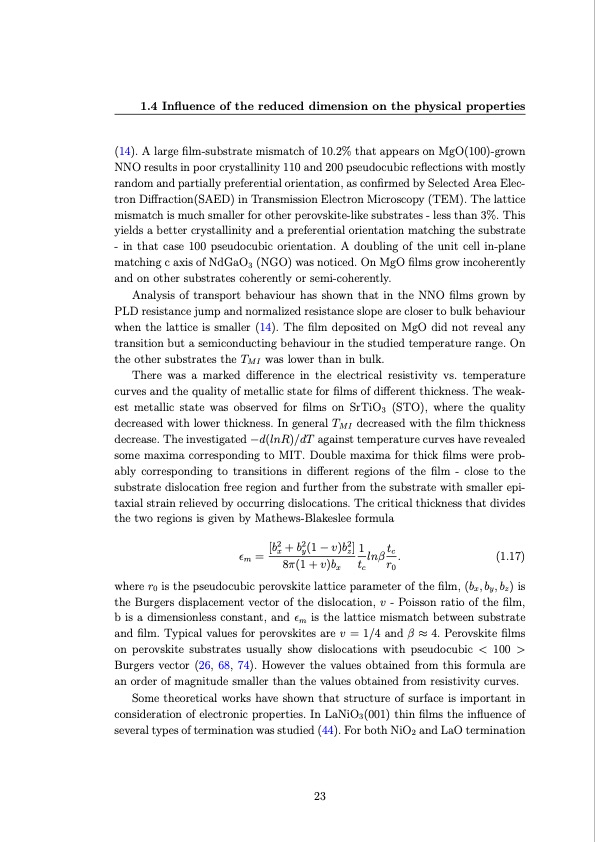
PDF Publication Title:
Text from PDF Page: 044
1.4 Influence of the reduced dimension on the physical properties (14). A large film-substrate mismatch of 10.2% that appears on MgO(100)-grown NNO results in poor crystallinity 110 and 200 pseudocubic reflections with mostly random and partially preferential orientation, as confirmed by Selected Area Elec- tron Diffraction(SAED) in Transmission Electron Microscopy (TEM). The lattice mismatch is much smaller for other perovskite-like substrates - less than 3%. This yields a better crystallinity and a preferential orientation matching the substrate - in that case 100 pseudocubic orientation. A doubling of the unit cell in-plane matching c axis of NdGaO3 (NGO) was noticed. On MgO films grow incoherently and on other substrates coherently or semi-coherently. Analysis of transport behaviour has shown that in the NNO films grown by PLD resistance jump and normalized resistance slope are closer to bulk behaviour when the lattice is smaller (14). The film deposited on MgO did not reveal any transition but a semiconducting behaviour in the studied temperature range. On the other substrates the TMI was lower than in bulk. There was a marked difference in the electrical resistivity vs. temperature curves and the quality of metallic state for films of different thickness. The weak- est metallic state was observed for films on SrTiO3 (STO), where the quality decreased with lower thickness. In general TMI decreased with the film thickness decrease. The investigated −d(lnR)/dT against temperature curves have revealed some maxima corresponding to MIT. Double maxima for thick films were prob- ably corresponding to transitions in different regions of the film - close to the substrate dislocation free region and further from the substrate with smaller epi- taxial strain relieved by occurring dislocations. The critical thickness that divides the two regions is given by Mathews-Blakeslee formula εm = [b2x + b2y(1 − v)b2z] 1 lnβ tc . (1.17) 8π(1 + v)bx tc r0 where r0 is the pseudocubic perovskite lattice parameter of the film, (bx,by,bz) is the Burgers displacement vector of the dislocation, v - Poisson ratio of the film, b is a dimensionless constant, and εm is the lattice mismatch between substrate and film. Typical values for perovskites are v = 1/4 and β ≈ 4. Perovskite films on perovskite substrates usually show dislocations with pseudocubic < 100 > Burgers vector (26, 68, 74). However the values obtained from this formula are an order of magnitude smaller than the values obtained from resistivity curves. Some theoretical works have shown that structure of surface is important in consideration of electronic properties. In LaNiO3(001) thin films the influence of several types of termination was studied (44). For both NiO2 and LaO termination 23PDF Image | Investigation of metal-insulator transition in magnetron sputtered samarium nickelate thin films

PDF Search Title:
Investigation of metal-insulator transition in magnetron sputtered samarium nickelate thin filmsOriginal File Name Searched:
Bilewska_Investigation_of_metal_insulator_transition_in_magnetron_sputtered_samarium.pdfDIY PDF Search: Google It | Yahoo | Bing
Sulfur Deposition on Carbon Nanofibers using Supercritical CO2 Sulfur Deposition on Carbon Nanofibers using Supercritical CO2. Gamma sulfur also known as mother of pearl sulfur and nacreous sulfur... More Info
CO2 Organic Rankine Cycle Experimenter Platform The supercritical CO2 phase change system is both a heat pump and organic rankine cycle which can be used for those purposes and as a supercritical extractor for advanced subcritical and supercritical extraction technology. Uses include producing nanoparticles, precious metal CO2 extraction, lithium battery recycling, and other applications... More Info
| CONTACT TEL: 608-238-6001 Email: greg@infinityturbine.com | RSS | AMP |